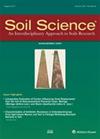环境因子和土壤性质对喀麦隆自然干燥热带地区土壤有机碳储量的影响
4区 农林科学
Q2 Agricultural and Biological Sciences
引用次数: 5
摘要
摘要对喀麦隆苏丹-萨赫勒地区土壤有机碳储量(SOCS)的研究很少。现有的少数几个主要在报告中提供,并且在大多数情况下涉及植物生物量的碳储量。为了对该国这一地区的土壤文献有所贡献,本工作旨在评估喀麦隆苏丹-萨赫勒地区自然干燥热带地区主要土壤类型中的SOCS以及环境因素和土壤性质对这些种群的影响。这项研究在四个地点进行,包括位于不同纬度的三个自然森林保护区(拉夫、扎迈、科索沃)和一个国家公园(莫索戈)。此后进行了两次重复,因此,在0至75厘米深度的每个地点选择了三个采样点,用于测定SOCS。在每个采样点,土壤取样使用深度增量25厘米的表面。所研究的区域包括单侧垂直气溶胶、单侧薄气溶胶、单侧薄气溶胶和单侧平气溶胶。75 cm深度T-SOCS含量随纬度增加而降低,为249±26.26 Mg。低纬度Laf森林保护区versols ha-1, 199±8.00 Mg。扎迈森林保护区气溶胶ha-1含量为166±16.63 Mg。科索沃森林保护区Leptosols的ha-1和161±8.88 Mg。在莫莫戈国家公园的Planosols中,无论海拔高低,都是如此。T-SOCS与海拔高度无显著相关。降水量随纬度的增加而减少,与T-SOCS呈良好的相关关系,说明气候对研究区T-SOCS的分布具有重要影响,直接影响植被的生产力。超过60%的SOCS储存在离土壤表面25厘米以下的地方,这是旱地SOCS的一个特点。喀麦隆苏丹-萨赫勒地区的SOCS主要受气候和植被影响。本文章由计算机程序翻译,如有差异,请以英文原文为准。
Effects of environmental factors and soil properties on soil organic carbon stock in a natural dry tropical area of Cameroon
Abstract. Researches carried out on soil organic carbon stock (SOCS) in the Sudano-Sahelian part of Cameroon are very rare. The few existing ones are mostly available in reports and concern in most cases carbon stocks in plant biomass. In order to contribute to the documentation on soils in this part of the country, the present work was designed to evaluate the SOCS in the main soil types and the influence of environmental factors and soil properties on these stocks under the natural dry tropical area of the Sudano-Sahelian zone of Cameroon. The study was undertaken in four sites, including three natural forest reserves (Laf, Zamai, Kosohon) and one national park (Mozogo), located at different latitudes. Two replications were thereafter made, thus, giving rise to three sampling points chosen per site, from 0 to 75 cm depth, for the determination of the SOCS. At each sampling point, soils were sampled using depth increments of 25 cm from the surface. The studied area is covered by Haplic Vertisols, Dystric Arenosols, Dystric Leptosols and Dystric Planosols. T-SOCS content, which refers to a depth of 75 cm, decreases with increasing latitude, with 249±26.26 Mg.ha-1 in Vertisols at Laf forest reserve in the low latitude, 199±8.00 Mg.ha-1 in Arenosols at Zamai forest reserve, 166±16.63 Mg.ha-1 in Leptosols at Kosohon forest reserve and 161±8.88 Mg.ha-1 in Planosols at Mozogo national park in the high latitude, regardless of the altitude. No significant correlation was noted between T-SOCS and the altitude. A good correlation was noted between precipitation which decreases with increasing latitude and T-SOCS, indicating the importance of climate in the distribution of T-SOCS in the study area, which directly influence the productivity of the vegetation. More than 60% of the SOCS was stored below the first 25 cm from the soil surface, a peculiarity of SOCS in the drylands. The SOCS in the Sudano-Sahelian area of Cameroon is mainly influenced by climate and vegetation.
求助全文
通过发布文献求助,成功后即可免费获取论文全文。
去求助
来源期刊

Soil Science
农林科学-土壤科学
CiteScore
2.70
自引率
0.00%
发文量
0
审稿时长
4.4 months
期刊介绍:
Cessation.Soil Science satisfies the professional needs of all scientists and laboratory personnel involved in soil and plant research by publishing primary research reports and critical reviews of basic and applied soil science, especially as it relates to soil and plant studies and general environmental soil science.
Each month, Soil Science presents authoritative research articles from an impressive array of discipline: soil chemistry and biochemistry, physics, fertility and nutrition, soil genesis and morphology, soil microbiology and mineralogy. Of immediate relevance to soil scientists-both industrial and academic-this unique publication also has long-range value for agronomists and environmental scientists.
 求助内容:
求助内容: 应助结果提醒方式:
应助结果提醒方式:


